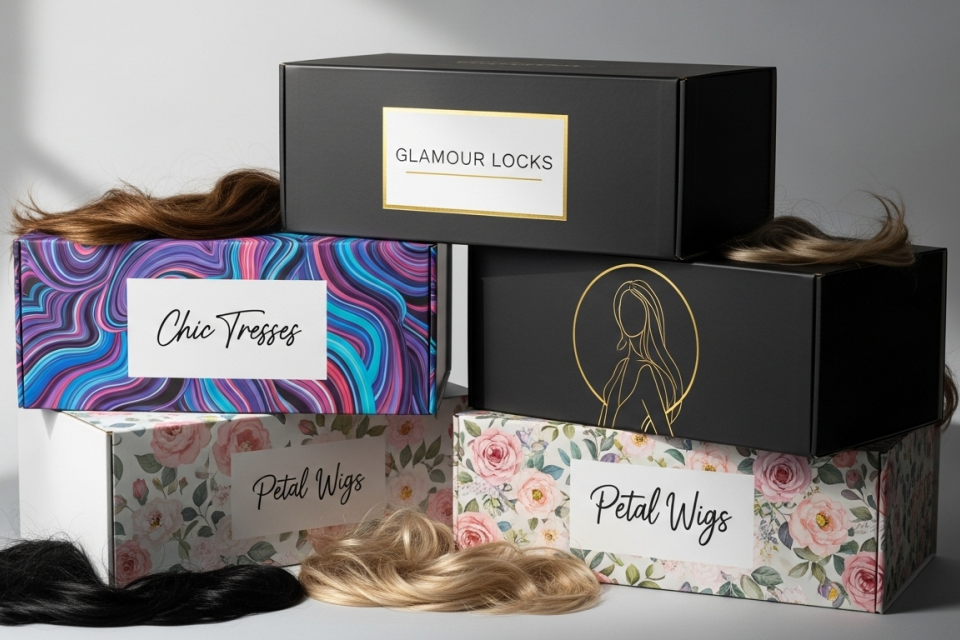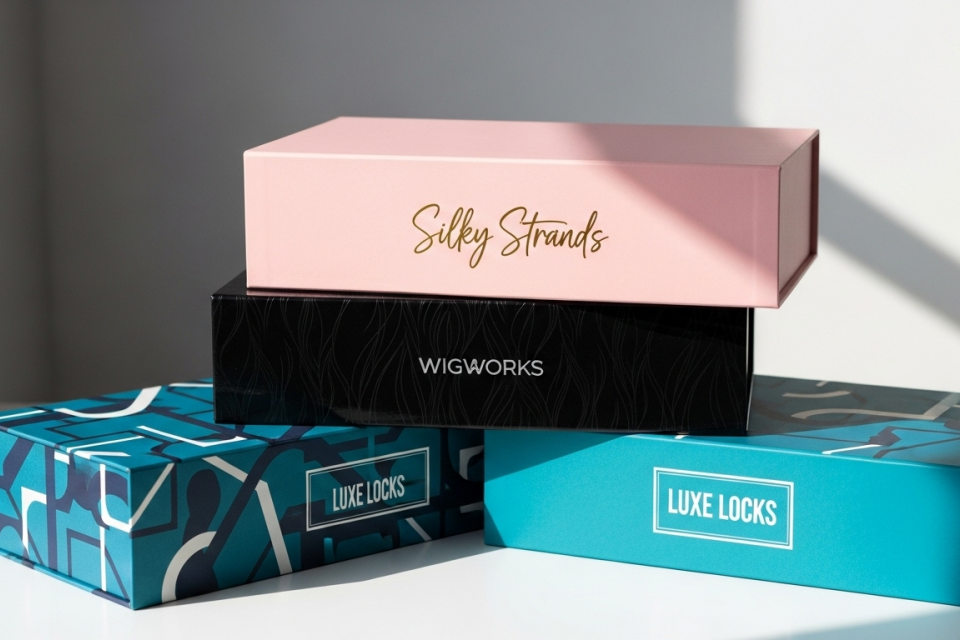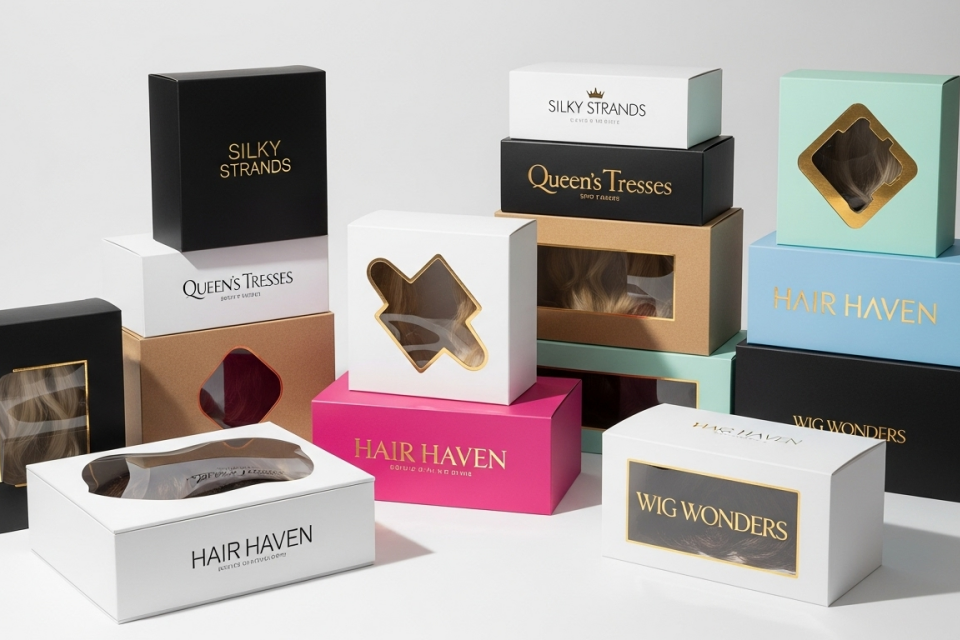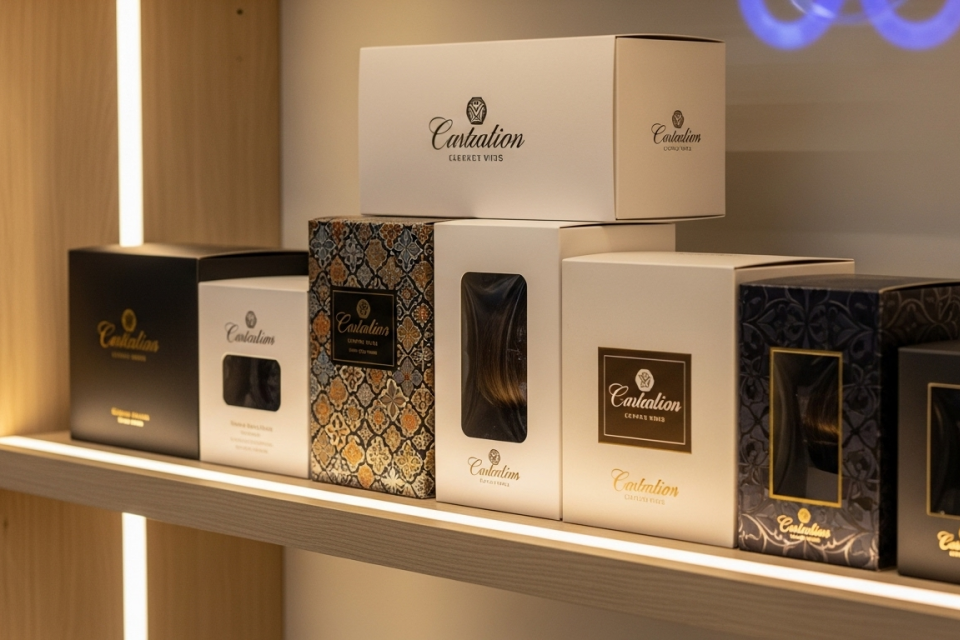Why Wigs Need Specialized Packaging
This blog explores why wigs need specialized packaging, from protection and branding to sustainability, regulations, and custom designs.
Summary
Wigs are versatile hairpieces that serve various purposes, including aesthetic enhancement, protection of natural hair, and support for individuals experiencing hair loss due to medical conditions. With two primary categories—synthetic and human hair wigs—each type offers distinct advantages tailored to different consumer preferences and needs. Human hair wigs are known for their natural appearance and durability, while synthetic wigs provide affordability and low maintenance, making them popular choices in diverse markets ranging from fashion to medical applications.
The packaging of wigs is a critical aspect of their distribution, significantly influencing the product’s safety, presentation, and sustainability during transport and retail. Specialized packaging is necessary to protect wigs from damage caused by environmental factors and rough handling, while also adhering to various regulatory standards. Notably, the challenge of balancing durability with aesthetic appeal has prompted manufacturers to adopt innovative packaging solutions that cater to a growing demand for eco-friendly materials and designs.
Controversies surrounding wig packaging primarily revolve around environmental impact and regulatory compliance. Many companies are under increasing pressure to minimize packaging waste and employ sustainable practices due to heightened consumer awareness and government regulations aimed at reducing plastic use. This has led to the exploration of biodegradable, recyclable, and reusable materials in packaging designs, reflecting a broader trend towards sustainability in the beauty and personal care industry.
As the wig market continues to evolve, the importance of specialized packaging becomes ever more apparent, driving innovation and influencing purchasing decisions. The interplay between consumer preferences, environmental concerns, and regulatory requirements underscores the significance of effective packaging strategies in ensuring the quality and appeal of wigs in an increasingly competitive landscape.
Table of Contents
Types of Wigs
Wigs are available in various styles and materials, each catering to different needs and preferences. The primary categories of wigs include synthetic wigs and human hair wigs, with each type possessing distinct characteristics and advantages.
Human Hair Wigs
Human hair wigs are considered a more eco-friendly alternative, offering durability, biodegradability, and the ability to be restyled without losing quality. These wigs provide a natural appearance and feel, closely mimicking real hair, which makes them a popular choice among consumers seeking authenticity in their hairpieces. While typically more expensive than synthetic options, human hair wigs can be viewed as an investment due to their longevity and versatility. They require more care to maintain their condition and can be styled with heat tools, similar to natural hair.
Synthetic Wigs
Synthetic wigs are crafted from man-made fibers, typically a blend of polymers such as acrylic, nylon, and polyester. These wigs are often favored for their affordability and low maintenance, as they retain their shape and style without requiring extensive styling tools. Additionally, advancements in technology have led to the creation of more sustainable synthetic materials, including options derived from recycled plastics, thus mitigating some of their environmental impact. However, synthetic wigs generally do not biodegrade, contributing to landfill waste. They are commonly used by individuals looking to change their appearance quickly or protect their natural hair, especially in contexts like cancer treatment or alopecia.
Medical Wigs
Medical wigs are specially designed for individuals experiencing hair loss due to medical conditions such as cancer or alopecia. These wigs can be made from either synthetic or human hair, depending on the user’s preference and needs. They are often designed with comfort and wearability in mind, accommodating sensitive scalps and providing a natural look that helps boost the wearer’s confidence during challenging times.
Protective Wigs
In addition to traditional styling purposes, wigs serve as protective styling options for those with natural hair. Protective wigs allow wearers to shield their natural hair from environmental factors, heat damage, and styling manipulation. This category includes a variety of styles, ranging from sleek and straight to curly and voluminous options, catering to diverse aesthetic preferences and cultural expressions.

Challenges in Wig Packaging
Wig packaging presents several challenges that manufacturers must navigate to ensure the safety and quality of the products.
Compliance with Regulations
One of the primary challenges is adhering to various regulations related to packaging waste reduction. Many countries have implemented laws requiring businesses to minimize packaging waste, which applies to wig manufacturers as well. Companies must develop strategies to reduce the amount of plastic and other materials used in their packaging while meeting legal requirements for waste reduction percentages. Failure to comply with these regulations can lead to legal issues and damage to a company’s reputation.
Safety Standards
Another significant challenge involves meeting safety standards designed to protect both workers and consumers. Packaging must be constructed from materials free of harmful chemicals or toxins that could pose health risks. This is crucial not only for consumer safety but also for reducing the risk of lawsuits, which can be costly and time-consuming for companies. Ensuring that packaging does not cause harm during handling or when being opened is paramount for maintaining consumer trust.
Variety in Wig Types
The diversity in wig styles and sizes further complicates packaging. Wigs come in various shapes, sizes, and materials, necessitating packaging solutions that can accommodate these differences. While some wigs can be packed in smaller poly mailers or zip bags, others require larger, custom-made boxes to ensure they remain undamaged during transportation. This variability requires manufacturers to invest in a range of packaging options to cater to their product lineup, leading to increased complexity and cost.
Protective Functionality
The primary function of wig packaging is to protect the wigs from damage. Packaging must be durable enough to withstand rough handling during shipping and storage. This often means using rigid materials like cardboard, along with additional protective elements such as bubble wraps. Balancing the need for sturdy packaging with aesthetic appeal can be challenging, as companies also want to present their products attractively to customers upon delivery.
Environmental Considerations
As the demand for sustainable products grows, wig manufacturers face the challenge of sourcing eco-friendly materials for their packaging. Companies are increasingly expected to implement sustainable practices, such as using recyclable or biodegradable materials, which can complicate the packaging design process. Manufacturers must be innovative in creating packaging that not only protects the product but also aligns with consumers’ growing environmental consciousness.

Specialized Packaging Solutions
The specialized packaging solutions for wigs play a crucial role in ensuring the products’ protection, presentation, and sustainability during transportation and retail. As the demand for high-quality wigs grows, particularly through e-commerce platforms, the necessity for durable and appealing packaging has become evident.
Importance of Durability
Wigs, often made from delicate materials such as synthetic fibers or human hair, require packaging that can withstand the rigors of shipping and handling. Effective packaging solutions must be designed to prevent damage from impacts, moisture, and exposure to environmental elements. Custom mailer boxes and shipping containers provide the necessary strength and protection, ensuring that wigs arrive at their destination in pristine condition.
Eco-Friendly Packaging Trends
In recent years, there has been a significant shift towards eco-friendly packaging solutions in the beauty industry, including wigs. Consumers are increasingly seeking products that align with their values regarding sustainability and environmental impact. Packaging made from biodegradable, recyclable, or compostable materials is gaining popularity, allowing businesses to attract eco-conscious consumers while reducing their carbon footprint. Innovative designs, such as refillable or reusable packaging options, are also being explored to further minimize waste associated with traditional packaging methods.
Aesthetic Considerations
In addition to functionality and sustainability, the visual appeal of wig packaging significantly influences consumer purchasing decisions. Attractive packaging that features unique designs, vibrant colors, and luxurious finishes can enhance the perceived value of the product. Moreover, well-crafted packaging not only protects the product but also serves as a branding opportunity, allowing companies to communicate their identity and ethos effectively.
Customization Options
Custom packaging solutions for wigs allow brands to differentiate themselves in a competitive market. Businesses can collaborate with design teams to create packaging that resonates with their target audience and reflects the brand’s image. Options such as matte or glossy finishes, embossing, and unique structural designs can enhance the tactile experience for consumers, making the unboxing experience memorable.

Industry Standards and Regulations
Wigs packaging is subject to various industry standards and regulations designed to ensure safety, sustainability, and compliance with international trade laws. These standards significantly influence how wig manufacturers approach their packaging processes.
Environmental Regulations
Many nations have implemented regulations aimed at reducing waste from packaging, requiring companies to minimize the amount of plastic and other non-biodegradable materials used in their packaging solutions. These regulations often set specific waste reduction targets, prompting wig manufacturers to adopt sustainable practices such as utilizing recyclable materials. By aligning with these environmental guidelines, manufacturers not only avoid legal complications but also demonstrate their commitment to eco-friendliness, which can enhance their competitive edge in the market.
Safety Standards
Wigs packaging must adhere to safety standards that protect both workers and consumers from harmful substances. Regulations prohibit the use of toxic chemicals and ensure that packaging does not pose a risk during handling or use. Compliance with these safety standards is essential for reducing liability and fostering consumer trust, ultimately saving companies time and resources while promoting a positive brand image.
Import and Export Regulations
The shipping of wigs across international borders is governed by strict regulations concerning labeling, duty rates, and inspection requirements. Manufacturers and distributors must remain informed about the laws in each country to prevent delays and fines that could adversely affect business operations. Proper adherence to these regulations is crucial for maintaining efficient supply chains and maximizing profit margins.
Advancements in Packaging Materials
The ongoing development of packaging materials has led to increased demands for durability and functionality in wig packaging. As e-commerce continues to grow, packaging must withstand the rigors of transportation while protecting the integrity of the product. Manufacturers are now turning to innovative materials that not only appeal visually but also provide the necessary protection against damage and contamination. This evolution in packaging aligns with consumer expectations for high-quality, resilient products, thereby influencing purchasing decisions.
Ethical Sourcing and Labor Standards
In response to rising social awareness regarding labor practices, many wig manufacturers are now emphasizing ethical sourcing and labor transparency. Companies are encouraged to adopt practices that ensure fair wages and safe working conditions for their workers throughout the supply chain. By prioritizing these ethical considerations, manufacturers can further align themselves with contemporary consumer values, enhancing brand loyalty and trust.

Environmental Impact of Packaging
The environmental impact of packaging in the beauty and personal care industry, particularly concerning wigs and hair extensions, has become a significant concern due to the high levels of waste generated by traditional packaging materials. Approximately 95% of cosmetic packaging is discarded, with about 70% of that waste ending up in landfills. To mitigate this issue, there is a growing shift towards sustainable cosmetic packaging that minimizes environmental harm and utilizes eco-friendly materials.
Sustainable Packaging Solutions
Sustainable cosmetic packaging encompasses a variety of strategies designed to reduce waste and promote responsible consumption. Key approaches include the use of biodegradable, compostable, and recyclable materials that break down more easily in the environment compared to conventional plastics. Additionally, companies are increasingly opting for refillable or reusable packaging solutions, such as glass jars and pump bottles, which significantly lower the volume of single-use plastics. Another crucial aspect of sustainable packaging is the design simplicity that eliminates unnecessary components. This minimalist approach not only reduces material usage but also aligns with the preferences of eco-conscious consumers who are steering away from traditional, wasteful packaging options.
Consumer Awareness and Demand
The demand for sustainable packaging solutions is being driven by a growing awareness among consumers regarding environmental issues. Eco-conscious shoppers are increasingly likely to support brands that demonstrate a commitment to sustainability through the use of biodegradable, renewable, or recyclable materials. This consumer trend not only enhances brand image but also fosters trust and loyalty among environmentally aware customers.
Moreover, the expansion of e-commerce has created a need for packaging that is not only aesthetically pleasing but also durable enough to withstand shipping and handling. This necessity encourages brands to invest in innovative materials that ensure product integrity during transit while still adhering to sustainable practices.
Reducing Carbon Footprint
Efforts to adopt sustainable packaging strategies contribute to reducing the overall carbon footprint of products in the beauty and personal care sector. By utilizing renewable resources and minimizing harmful waste, companies can ensure that their products, including wigs and hair extensions, have a lesser impact on the environment. This shift towards sustainability is not only beneficial for the planet but also represents a significant step in transforming the perception of beauty and sustainability within the industry.
